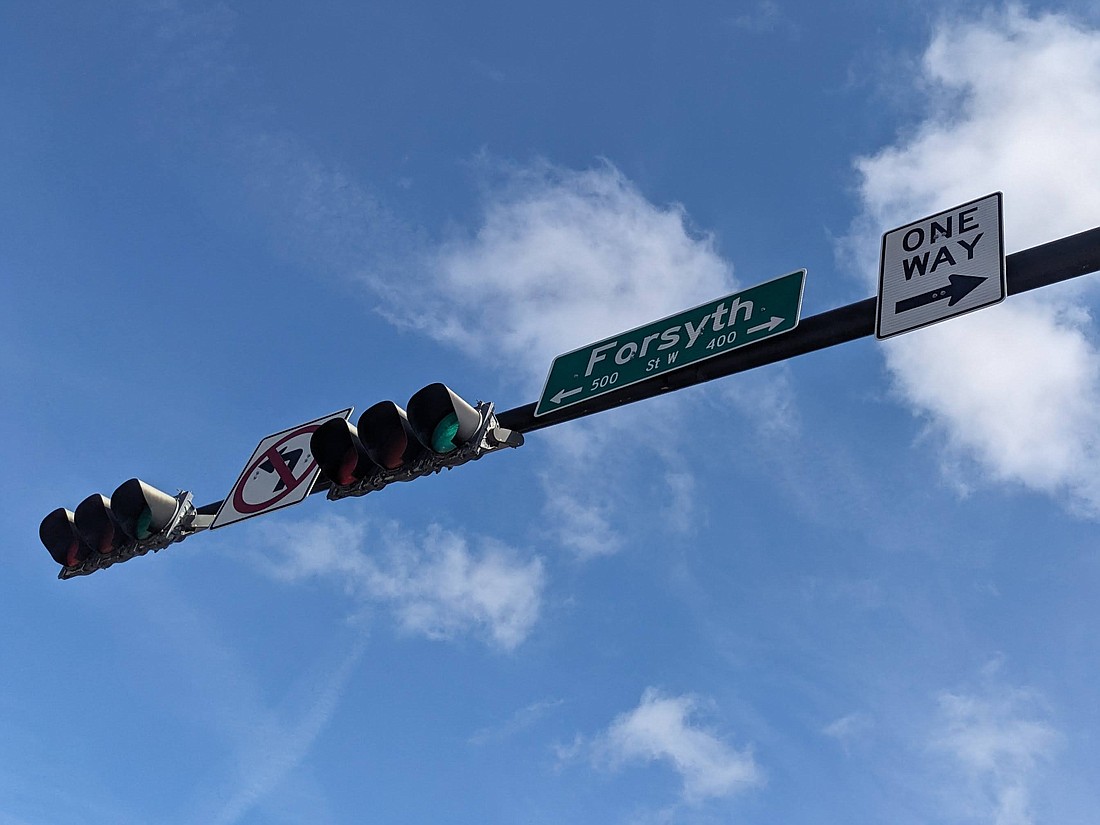
Work is underway to restore two-way traffic on stretches of two Downtown streets.
Downtown Investment Authority CEO Lori Boyer recently told the Downtown Vision Inc. board that construction has begun to reconfigure Forsyth and Adams streets for two-way traffic from Jefferson to Liberty streets.
The work is being done under a $4.6 million revised contract approved in October 2023 with Jacksonville-based EltonAlan Inc., an engineering and construction firm.
Boyer, a member of the DVI board, said crews have started prep work to install new signal devices at intersections. That work is part of the first phase of the two-phase project.

As part of Phase I, Boyer said, the streets would be restriped and traffic would be converted to two-way. The second phase involves work such as moving curbs and widening portions of sidewalks, she said.
Phil Perry, chief communications officer for the city and Mayor Donna Deegan’s administration, said in an April 4 email that EltonAlan is running underground traffic signal conduit and completing orders for construction materials.
Perry said the city expects road construction to begin this summer, including lane shifting and repaving asphalt. Between now and then, traffic signal infrastructure will be installed and construction materials will start to arrive, he said.
Originally two-way
The streets originally were designed to be two-way but were changed decades ago during a car-first time in traffic engineering.
At that time, engineers prioritized quick movement for commuters to and from Downtown workplaces over walkability and commerce.
Boyer and the DIA uses the term two-way restoration versus conversion to emphasize that the streets will be a modernized version of their original design.
One aim is to slow traffic and make the streets safer for walking, cycling and other modes of transportation like scooters.
The restoration also is designed to make more efficient use of on-street parking and ride-sharing.
The overall goal is to encourage pedestrian activity, increase mobility and foster development of street-level dining and retail.
The idea is that those businesses will benefit from increased foot traffic and patronage by motorists who are more likely to notice storefronts along the streets while traveling at lower speeds.
The project is part of the DIA’s strategy for revitalizing Downtown, which includes a focus on attracting residents and new businesses to the area, improving quality of life, creating a cyclical effect of redevelopment and driving up property values.
Boyer told the DVI board that the first phase of the restoration is expected to be completed in less than a year. The second phase is in design.
Similar conversions
Several cities across the U.S. have made similar conversions, and projects in other cities are underway. They include a $46 million-plus conversion of eight streets in Indianapolis.
A 2015 study of conversions in Louisville, Kentucky, showed that accidents decreased as much as 60% after two-way traffic was restored on two city streets in 2011.
The study, which compared the data from the two years after the conversions with the four years before, also showed an increase in property values along the converted streets, although the study’s authors noted that factors other than the new traffic patterns were likely involved.
In a November 2023 editorial about the two-way conversion of Main Street in Vancouver, Washington, The Columbian newspaper said the project had rejuvenated the central business district since it was completed about 10 years ago.
The editorial stated that a street that used to provide “a one-way trip leading out of town” had become the center point of “a revival that enhances life for residents and attracts visitors from near and far.”
Traffic concerns
Detractors of street conversions say they’re not as efficient at moving traffic as one-way streets and increase the possibility of head-on collisions. Another concern is that two-way streets create congestion for fire trucks and other emergency vehicles, increasing response times.
Proponents counter that two-way streets provide a more direct route to destinations and reduce the possibility of high-speed vehicle-pedestrian accidents.
The U.S. Department of Transportation reports that traffic tends to move faster on one-way streets than two-way streets. Although one-way streets require pedestrians to look for oncoming cars in only one direction, the transportation department says several studies have shown that conversion to two-way traffic reduces pedestrian accidents.
The department also says two-way configurations slow traffic through “friction,” with drivers slowing to contend with oncoming traffic and pedestrian traffic.
On College and Post streets in Riverside and Avondale, which were converted to two-way traffic in 2006, it is common to see cars slowing and pulling to the curb to allow oncoming cars to pass by.
In 2021, the city approved a $1.33 million contract with Jacksonville-based Prosser Inc. for two-way mobility and safety engineering services.
Prosser produced a design for Forsyth and Adams streets that included 10-foot travel lanes and seven-foot parallel parking spaces, plus new features such as protected “parklets” with seating areas, steel planters and wood flooring.
The contract with EltonAlan includes all facets of the conversion, including milling and resurfacing, signal and sign installation, pavement marking installation, utility alterations and maintenance of traffic.